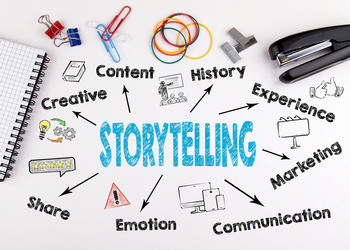Three Steps To Storytelling Success In Your Job Search

The best storytellers have one thing in common: they rarely wing it. Once you’ve learned the formula for a great speed networking pitch (in just three easy steps), you won’t have to wing it either.
Let’s take a look at the three steps that can make your networking pitch stand out with stories of your most successful moments.
Step 1: Uncover Your “Greatest Hits”
Many people struggle to identify their accomplishments because they see those peaks as “just part of their job.” To get your ideas flowing, you have to banish those thoughts. All bets are off and all answers are good ones. To sell yourself and (perhaps more importantly) encourage someone to continue speaking with you in the first place, you must first formulate a list of career “greatest hits” (think 80’s mixed tape!) and how you “saved the day, solved the problem or served the client” in your current or previous jobs.
The Five O’Clock Club generated the ridiculously effective “The Seven Stories Exercise” to rev up your accomplishment engine and get you to pinpoint your successes with ease.
Start by writing down your top seven most satisfying experiences. (In this case, they should be mostly professional.) Each of these accomplishments should meet the following criteria:
- You were happy when you did it.
- You thought you did it well (so, it wasn’t a fluke).
- You experienced a sense of accomplishment.
Here are some examples:
- Digitized the entire patient history in my office.
- Redesigned the quarterly newsletter to include member interviews.
- Navigated through Italy without a translator.
Step 2: Challenge – Action – Result (CAR!)
After you’ve written down your accomplishments, it’s time to format them in a way that breathes some life into the story. What was the challenge? What action did you take? What was the result?
Here are some examples:
- Challenge: Oversaw 70 upgrades across all departments after epic system shutdown shaved two weeks off of allotted time.
- Action: Called for all hands on deck, delegated responsibilities and implemented planned course of action.
- Result: Accurately completed upgrade in a third of the time originally scheduled.
- Challenge: Raise test results by 10% to maintain school funding.
- Action: Developed school-wide initiative to incentivize tutoring for both teachers and students.
- Result: Reached average increases of 15% with 6th grade topping at 24%. Maintained funding and raised the standard for years to come.
- Challenge: Remodeled outdated communications system at traditional company with minimal budget.
- Action: Researched most efficient channels with free applications and best results.
- Result: Increased email subscription by 15% and social media followers by 150% in under three months.
Step 3: Create your pitch!
Now it’s time to craft a winning Speed Networking Pitch. Use this formula below to take the guess-work out of yours so you can begin using it quicker.
“As a [job title], I work with [share target audience] to [share a problem you solve]. And here’s the proof [tell a specific story].”
Here are some guidelines to help you stay on track, intrigue your audience and nail your speed networking pitch.
- Keep it simple: Don’t take 20 words to say what you can say in one. You have about 30 seconds to get your point across. Each word you choose to say takes up valuable real estate in your listeners’ minds. (Don’t make them want to go freshen their drink!)
- Drop the jargon: Everyone knows the corporate buzzwords — “holistic,” “facilitate,” “move forward!” This, however, is not the time to use them. People want to hear an authentic overview of your expertise, not a keyword-heavy speech that feels scripted and confusing.
- It’s in the present: This is what you continuously do, not what you’ve previously done.
- Make it about the client: Rather than talking about your accomplishments, design your stories to highlight how you made things better FOR YOUR CLIENT. This last piece is the key. It’s not about you. This is what makes this pitch exercise different than the others you’ll find. The best way to do this is to showcase proven results of your work and how the business benefited.
Here are some examples:
- [As a Public Relations Specialist] I work with [serious product developers who have been in business for five years or more] who are looking to [fine-tune and/or rev up their public relations engine and start landing some media coverage on national scale]. [Recently, I helped my client land a 1/2 page feature in the Washingtonian Magazine and, as a result, he is now in discussions with X company to sell the app for $1.3M].
- [As a project manager at a credit union] I work with [a team of financial and technical experts] to [develop and rigorously test new products and services]. [Last month, my team launched a hugely anticipated line of corporate banking, which has already led to a 23% increase in business and billable accounts.]
- I work with [small to medium-sized non-profits who specialize in women and children] who need help [blending photography, graphics and text to attract demographics and prompting consumers to use their service. [Recently, I worked with the Coalition for Women and Children to rebrand their marketing collateral, which doubled traffic at their table at the Taste of Bethesda last weekend — unique booth visitors grew from 350 to 700 in two days!]
- Just for fun, here’s my own: As a [Job Search Coach], I work with [job seekers who are struggling in their search, sending out resumes and/or not getting interviews] and I [teach them proven job search methodology that enables them to stop spinning their wheels and shave months off their job search]. Just last week, I helped a job seeker [return to the workforce after a near fatal car accident and a 12-year hiatus. She’s so empowered and excited to start her new life].
After you’ve decided which accomplishments you want to demonstrate, diversify your arsenal to create an unstoppable repertoire of stories. It’s important to have a few on hand so you can tailor them to suit your audience.
Last but not least, practice! If it makes you feel uncomfortable to say it, don’t! If you wouldn’t use a word in real life, it sure as heck does not belong in your pitch. Natural, authentic storytelling is what we’re after here. Now, it’s your turn.
As the CEO of The Career Strategy Group, Laura M. Labovich partners with companies, nonprofits and associations to help them nurture their workforce through the inclusion of innovative, flexible and high-touch outplacement services. Laura and her team also coach job seekers all over the world, from entry-level to executive, to fearlessly and confidently manage their careers and land lucrative, meaningful jobs they love. Before founding The Career Strategy Group, Laura recruited nationwide for Walt Disney World and developed the college internship program at America Online. Laura’s advice has been featured in national news outlets including The Washington Post, Sirius XM, NBC 6 (Miami) and dozens of others. Laura is the co-author of 100 Conversations for Career Success: Learn to Network, Cold-Call, and Tweet Your Way to Your Dream Job, a 2013 top career book selection by FORBES.com. Learn more about Laura.
Contributing Writer(s): Laura Labovich, '94 '99



